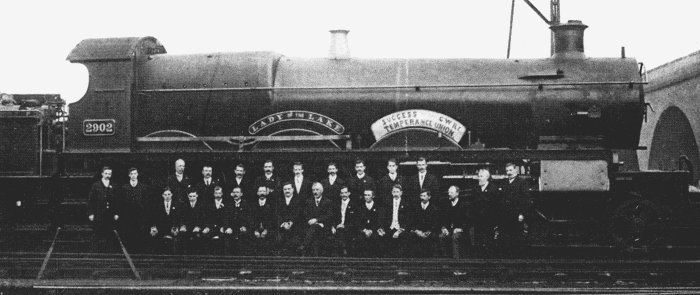
In 1890 the GWR Temperance Union
began to meet at the GWR Institute building that fronted
the Stafford Road, and by 1895 the membership stood at
1,047. The officers and committee of the Wolverhampton
No 1 branch of the GWR Temperance Union pose in the shed
yard in front of Saint' class 4-6-0 No 2902 Lady of the
Lake, a Swindon Works product of 1906. The
multiplication of the 'Castles' would eventually
displace the 'Saints' from all the heaviest runs, the
few local survivors thereafter being put to use on
semi-fast and stopping trains. Author's collection/GWR
Magazine. |

The Wolverhampton (Stafford Road)
football team in 1922, just before the Grouping. The
club was started by the Works Manager, Charles Crump, as
early as 1876, and when the team played the Walsall
Swifts at Fox's Lane in 1879 it was before a crowd of
2,000. The Swifts, however, complained that spectators
had lined the goal areas, preventing their team from
scoring. Crump maintained an interest in the club for
the rest of his days. GWR Magazine. |
|
As to be expected, World War I soon
impacted on the Stafford Road sheds and works. Britain's
railways immediately came under Government control by
way of The Railway Executive Committee (REC), and by
October 1914 the locomotive crews were already having to
undertake extra work in order to cover additional troop,
goods and passenger trains. However, at the same time
Wolverhampton's railway employees generally were
starting to leave their employment to heed the call to
join the 'Colours'. As a result, by November a letter of
release had to be obtained to produce to the local
recruitment officers, giving permission for enlistment.
Despite this worsening situation, the Stafford Road
footplate crews were soon having to contend with the
introduction of the new 1915 GWR summer timetable, which
boasted no less than 13 Wolverhampton (Low Level) to
London (Paddington)-only expresses.
Following compulsory recruitment
being introduced in 1916, it became necessary for the
GWR to take on women workers at Stafford Road works and
shed, in order for them to assist in locomotive
cleaning, stores, and other general work for the
duration of the war. Those railwaymen in essential
posts, such as footplate staff, signalmen and shunters,
were of course exempt from enlistment in any event.
Although they would have presented
a prize target, the locomotive sheds and works at
Stafford Road and Oxley all remained intact on the night
of Monday, 31 January 1916 when a Zeppelin bombing raid
took place across the Midlands by German airships L19
and L21. Fortunately, as a result of prior warning,
blackout restrictions were in place, and although
Wolverhampton was on airship L19's route, it completely
missed the town, but sadly caused extensive damage and
civilian fatalities at other locations in the Black
Country. The GWR Roll of Honour for 1914-18 shows that
by the time of the armistice 51 railway workers from
Wolverhampton had given up their lives, mainly on the
battlefields of Flanders and northern France.
As previously mentioned, prior to
World War I eleven 'Saint' class 4-6-0s had been sent to
Stafford Road shed, replacing the 'City' and 'Flower'
class 4-4-0s on the London trains. The original Great
Western locomotive registers kept in the Public Record
Office at Kew for 1 January 1921 record that (inclusive
of the works crane locomotive) there were 208
locomotives then allocated to Wolverhampton. This list
is a combination of both Stafford Road and Oxley sheds,
but it does provide a snapshot and confirms that
Wolverhampton was at one time the largest running centre
on the GWR. At the time of the locomotive Grouping, on 1
January 1923, the two-cylinder
'Saints' had themselves been
superseded by the four-cylinder 'Star' class 4-6-0s. By
now the number of 'Saints' allocated to Wolverhampton
had dropped to three, with no less than eleven 'Stars'
as stable mates. The 'Star' class 4-6-0s were regulars
at Stafford Road shed right up until 1954.
The Grouping had little obvious
impact at Stafford Road shed, which already had a
history of playing occasional host to locomotives
originating with the various subsidiary Welsh and
Shropshire lines, things carrying on much as before. The
opening of the new GWR goods locomotive shed at Oxley
had freed up some extra locomotive capacity at Stafford
Road shed and, as a result, one of the running sheds was
allowed to fall into disuse by 1923. From the late 1920s
onwards almost every type of modern GWR steam locomotive
(with the exception of The Great Bear) must have either
been allocated to, or visited, Stafford Road shed at
sometime. An effect of the major reorganisation and
expansion at the works during the course of 1932 was
that the 1850s former broad gauge shed in the lower yard
was brought back into use as a locomotive shed, with the
Road Motor Department taking over shed No 3, while shed
No 2 continued in use into the 1940s.
'No less than eight 'Kings' were
allocated to Stafford Road shed by 1932, and the
footplate crews often received praise for their spirited
performances on the two-hour expresses to Paddington'
Despite the spectre of mass
unemployment, which blighted the nation in the years
following World War I (peaking in the 1920s and 1930s),
the number of people making train journeys did not
significantly decrease. During 1927/28 the GWR was
confident enough to invest in the construction of its
famous 'King' class 4-6-0 locomotives at Swindon Works.
A substantial amount of work performed by the 'Kings'
was between London (Paddington), Birmingham (Snow Hill)
and Wolverhampton (Low Level). No 6000 King George V
soon appeared at Wolverhampton in the summer of 1928,
with the local Express & Star newspaper carrying a
photograph of the locomotive, the accompanying caption
reading 'Daily Visits of a Giant'.
No less than eight 'Kings' were
allocated to Stafford Road shed by 1932, and the
footplate crews often received praise for their spirited
performances on the two-hour expresses to Paddington -
to some extent this period represented a high watermark
of express passenger locomotive working from
Wolverhampton. The number of 'Kings' allocated to
Stafford Road shed remained fairly constant over the
years at between four and seven. An allocation list for
31 December 1947 recorded Nos 6005, 6006, 6008 and 6011
- Nos 6005 and 6006 were Stafford Road engines for most
of their lives.
The presence of the 'Kings' and
also the 'Castle' class 4-6-0s (mainly from the 1930s
onwards), together with a host of other classic GWR
locomotives, reflects that the inter-war years of the
1920s and into the late 1930s were indeed the so-called
'golden age' of steam railways in Great Britain. The
allocation of 'Kings' and 'Castles' to Stafford Road
shed remained as a permanent fixture right up until
closure. True to form, however, Wolverhampton also
continued to maintain its usual eclectic Northern
Division collection of newer mixed-traffic 4-6-0s, old
outside-framed tender engines and various types of tank
engine. Additionally, due to its close proximity to the
works, newly out-shopped locomotives were often seen in
the shed yard or over at the coaling bay, being prepared
to be put back into service. |
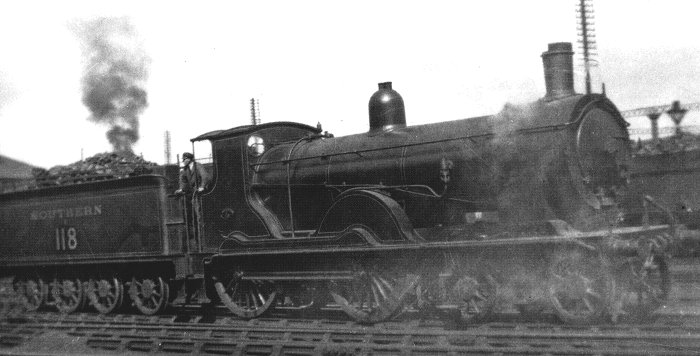
Former L&SWR 'T9' class 4-4-0 No
118 is freshly coaled up in the yard at Stafford Road
shed circa 1930. Southern Railway engines, Drummond
types such as'T9s' and 'D15s', worked a regular train
from Bournemouth to Wolverhampton every Friday during
the summer season from the 1920s up to the mid 1930s.
The crew would then spend the night lodging in
Wolverhampton, returning south the following day. 'King
Arthur' class 4-6-0s were also to be found on this duty
before it was finally discontinued. Other SR traffic
visits into the Black Country resulted from the 8 July
1929 introduction of through bookings from Wolverhampton
(Low Level), via the Southern Railway, to various
locations in Europe. Author's Collection. |
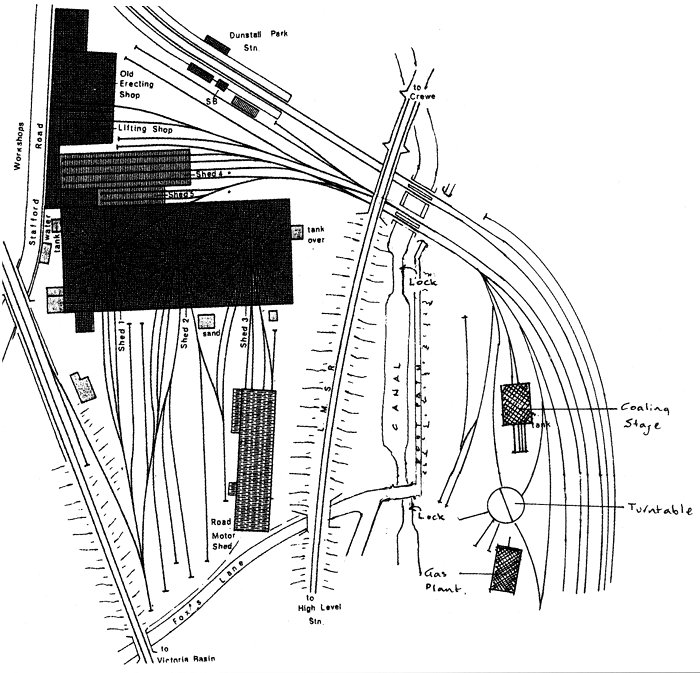
The last significant evolution
of the Stafford Road shed and yard facilities came
in 1932, this diagram covering this period and
mapping out the three roundhouses, (shed Nos 1 to
3), the ex-broad gauge shed (No 4) - now back in use
by locomotives - and the neighbouring 'Arcade' (No
5), as well as confirming the location of Dunstall
Park station. Of note is the shed access off the
ex-S&BR Victoria Basin line, in addition to the
primary access off the Wolverhampton (Low Level) to
Oxley link, along with the coal, gas plant and open
air turntable facilities to the east of the LMS
route (shown as 'to Crewe' and 'to High Level Stn').
Part of a massive railway site, these facilities are
in effect just for the everyday operation of
passenger locomotives, the Stafford Road itself
having increasingly provided a boundary between the
shed and works sites, with Oxley shed, further
north, servicing the goods fleet. Author's
Collection. |
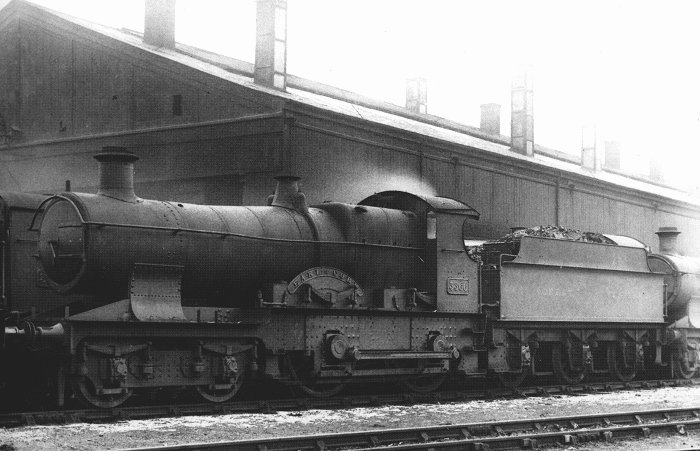
Thirty-year-old Great
Western 'Bulldog' class 4-4-0 No 3366 Earl of
Cork is seen in 1933 alongside the entrance to
the old broad gauge shed, which was now
designated shed No 4. The timber clad part of
the building in view is the circa 1870 extension
to the original 1857 brick-built structure. The
extension was by way of cast-iron pillars
supporting a girder lattice-style roof. The
'Bulldogs' were to be found across the GWR
system working secondary expresses or main line
freight work. Notably, 'Bulldog' No 3390 was
named Wolverhampton until l927, when its
nameplates were removed, apparently to avoid
confusion being caused to passengers as to the
train's actual destination! Author's Collection. |
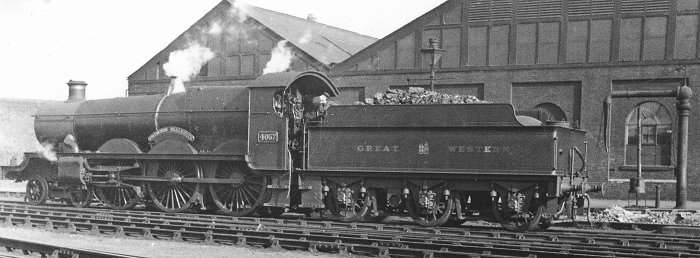
Churchward 'Star' class 4-6-0 No
4057 Princess Elizabeth in 1935 by the northern wall of
turntable sheds Nos 2 and 3, or 'B' and 'C', with the
latter on the left. The embankment of the LMS (ex-L&NWR)
Stour Valley line is seen just to the left of the
locomotive's smokebox. It is believed that up to eleven
'Stars' had been allocated to Stafford Road by 1923,
primarily for working secondary expresses, and there
were still six in use at Wolverhampton by 1950. Author's
Collection. |
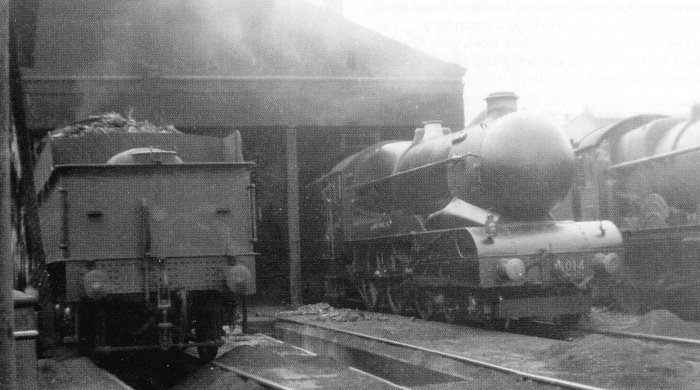
'King' class 4-6-0 No 6014 King
Henry VII is pictured on Stafford Road shed in partly
streamlined form during 1935 - the streamlined casing
and bullet nose were fitted at Swindon Works in March of
that year. This locomotive was featured in a Pathé
newsreel film with a commentary to the effect that it
would be used to attack the railway speed record.
However, the streamlining was, in reality, more of a
publicity stunt by the GWR, and all the extra casings
were removed by January 1943, apart from its 'V-shaped'
cab. D. K. Jones Collection. |
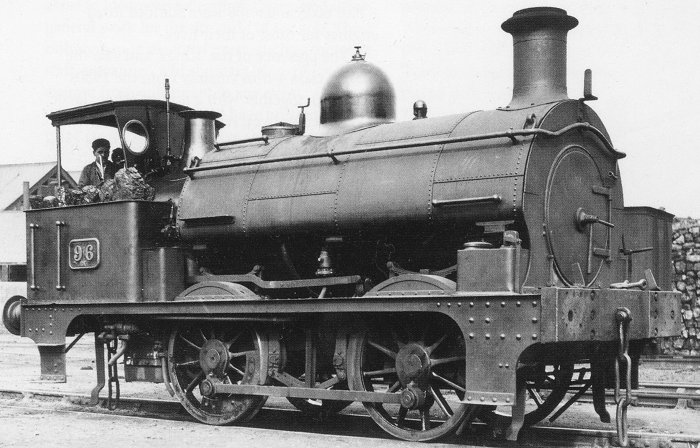
GWR No 96 poses for the camera at
Wolverhampton (Stafford Road) in 1930, a few years
before its withdrawal after 79 years of service, nearly
all in the GWR's Northern Division. Completed by Sharp,
Stewart & Co (Works No 964), it was delivered in 1856 as
Chester & Birkenhead Railway No 39 Cricket. The company
was renamed as the Birkenhead Railway from 1 August
1859, and Cricket was acquired by the GWR in January
1860, when the Birkenhead Railway was vested jointly
with the GWR and L&NWR. As No 96 it received a major
rebuild at Wolverhampton Works in 1888, and doubtless
this saw the end for most of the original locomotive,
remarkably though the 1888 boiler was still in use when
this saddle tank was finally withdrawn in November 1935.
Author's Collection. |
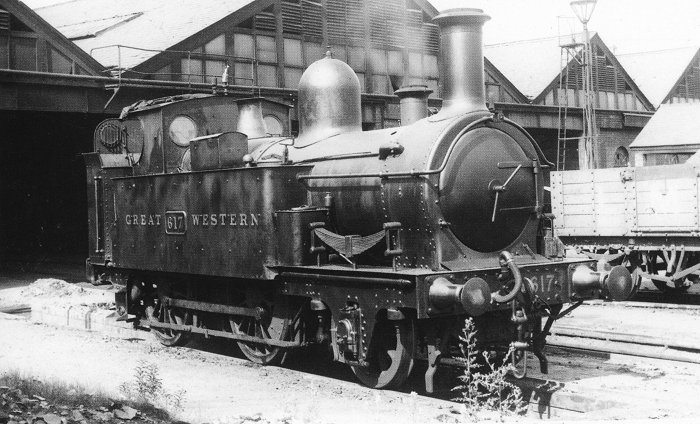
Fitted with a Wolverhampton-style
bunker and backplate, '613' series 'Metropolitan' 2-4-0T
No 617 stands outside the main turntable sheds at
Stafford Road circa 1930. The name of this class was
derived from the engines' association with the
Metropolitan Railway, over which so many of them worked.
With the cessation of the Metropolitan services a number
of these engines started to appear for the first time in
the GWR's Wolverhampton Division, at Wellington,
Wolverhampton and at other depots. No 617 was allocated
to Aberystwyth in about 1931, and it was probably the
only engine of this class ever to be stationed in the
Central Wales Division; it was withdrawn during May
1934. Author’s Collection. |

On 21 February 1937 we find two
GWR '3206' class 'Barnums' at Stafford Road shed, as
viewed from Fox's Lane. Locomotives Nos 3222 and 3210
are of 1889 vintage and both are out of use, although
they would not be officially withdrawn for another two
weeks, being the last of their class to remain in
service. A class of 20 locomotives, the 'Barnum' was one
of William Dean's most successful 2-4-0 designs, and
they were often seen on shed at Stafford Road, and
passing the shed on local passenger trains between
Wolverhampton (Low Level) station and Wellington or
Shrewsbury. As a class, these engines were the last GWR
type built with two-inch sandwich-type frames, and it is
probable that Nos 3222 and 3210 had previously been put
to use on Cambrian main line workings. Author’s
Collection. |
|
One of the less-popular classes
allocated to Stafford Road shed in the late 1920s was
the '3800' or 'County Tank' 4-4- 2T of 1904-12, four of
which were used on fast trains to Chester. Nicknamed
'Airships' as a result of their unusual footplate height
above rail level, they were prone to spilling water out
of the side tank vents when being driven along the
heavily-canted curves at Stafford Road. This unwelcome
situation sometimes resulted in locomotive crews having
to make unscheduled stops for water further along the
line. Most of the 'County' tanks were withdrawn by 1931,
although 'County' class 4-4-0 No 3834 County of Somerset
survived in use at Wolverhampton until November 1933, by
which time it was the last member of its class in
service.
Despite the difficult economic
background, railways in the 1930s were now subject to a
period of expansion and innovation, in direct
competition with the ever-increasing threat from road
transport. Historically, timings regularly achieved by
Stafford Road footplate crews on some main line workings
from Wolverhampton during the mid-1930s were never
bettered until after the demise of steam some 30 years
later. The locomotive crews at Stafford Road also had
their own local opposition to spur them on, provided by
their London, Midland & Scottish Railway (ex-L&NWR)
counterparts over at Bushbury locomotive shed, a short
distance away across town. By 1937 an employee booking
on for duty at Stafford Road shed could now be more
optimistic as to the future. However, everything changed
again in September 1939 with the outbreak of World War
II.
Similar circumstances to those
applied during World War I soon arose. This time around
most railway employees were deemed to be in reserved
occupations, so as to prevent indiscriminate recruiting,
but those that could be spared were soon released for
call-up, and many of the staff from the sheds and Works
also joined the local Air Raid Precautions or Home Guard
units. Women employees were also taken on again by the
GWR at Stafford Road, in order to carry out locomotive
painting and cleaning, and a multitude of other tasks,
but, as was the case during World War I, at lower
comparative wages than their male counterparts would
have received.
Drivers and firemen also had to
acclimatise themselves with some of the War Department
'Austerity' and United States Army Transportation Corps
2-8-0s, which had been put into service with the Great
Western Railway, together with the occasional Stanier
'8F' class 2-8-0 loaned by the LMS, so as to help
relieve the acute locomotive shortage during the war
years. After some early initial use and running-in, the
United States Army Transportation Corps locomotives were
then shipped abroad.
Unlike the itinerant Zeppelin raid
back in 1916, there was now a very real danger that
Wolverhampton would soon be targeted by the Luftwaffe
bombing raids that were being carried out across the
industrial Midlands. Night-time blackout restrictions
had been put into operation at the shed right from the
very start, often creating dangerous working conditions
in the minimum lighting allowed. Employees at Stafford
Road Works were also soon hard at work fitting canvas
sheeting and steel anti-glare plates, enclosing
locomotive cabs so as to restrict the glow from the
firebox. Unfortunately this gave rise to sweltering
conditions on the footplate, especially in the
summertime. Incredibly, in the event no bomb damage was
ever sustained, either at Stafford Road or over at
Oxley.
For the duration of the war,
substantial levels of increased work had to be
undertaken to provide motive power to deal with troop
trains, constant freight movements, including munitions,
and a host of other defence-related and sometimes risky
train diagrams, often in blackout conditions, towards
maintaining the national war effort. On a lighter note,
at one time a contingent of Italian prisoners of war
were sent to Wolverhampton to do manual work at both the
GWR and LMS sheds. Those who knew them remember their
singing abilities, which is not surprising as some had
previously been members of the Milan Opera Company
before the war. These POWs were carefully watched over,
either by regular soldiers or sometimes the local Home
Guard, both at the sheds and when out working along the
line.
Following the end of the war in
1945, employees at Stafford Road shed might have been
tempted to believe the popular wartime saying that 'the
good times were just around the corner', even though the
immediate post-war austerity years were, of necessity, a
period of re-adjustment and rehabilitation. |
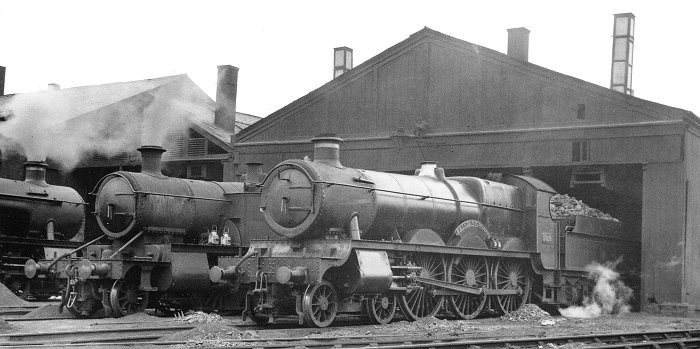
GWR 'Saint' class 4-6-0 No 2926
Saint Nicholas stands outside the old 1850s four-road
ex-broad gauge shed on 3 July 1937. The original wooden
cladding on the gable end of the later extension to the
building is still mainly intact at this time, although
it will eventually be replaced by corrugated iron
sheeting in the 1950s. The slightly shorter double-track
No 5 shed, known as 'The Arcade', is the building just
visible to the left. The locomotive pictured would
remain in service until September 1951, having latterly
been employed on semi-fast and stopping trains. Author’s
Collection. |
 |
|
 |
|
 |
Return to
part 2 |
|
Return to
the beginning |
|
Proceed to
part 4 |
|